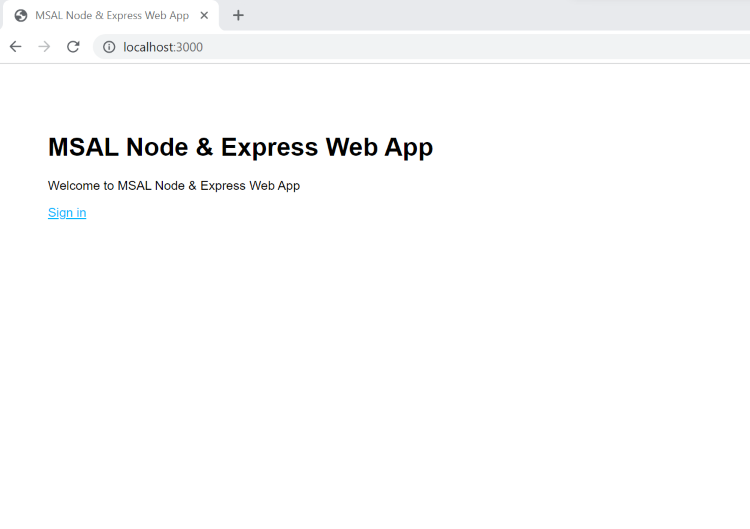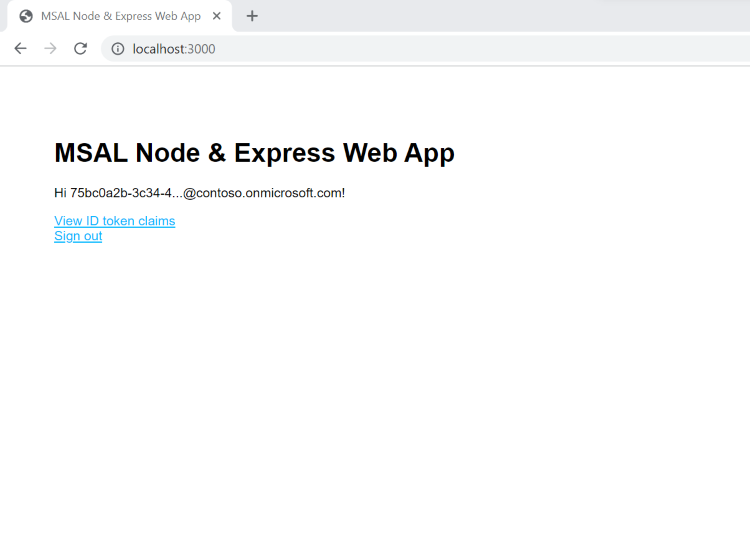Sign in users in a sample Node.js web application
This guide uses a sample Node.js web application to show you how to add authentication to a web application. The sample application enables users to sign in and sign out. The sample web application uses Microsoft Authentication Library for Node (MSAL Node) for Node to handle authentication.
In this article, you do the following tasks:
Register a web application in the Microsoft Entra admin center.
Create a sign-in and sign-out user flow in Microsoft Entra admin center.
Associate your web application with the user flow.
Update a sample Node.js web application using your own external tenant details.
Run and test the sample web application.
Prerequisites
- Visual Studio Code or another code editor.
- Node.js.
- .NET 7.0 or later.
- An external tenant. If you don't already have one, sign up for a free trial.
Register the web app
To enable your application to sign in users with Microsoft Entra, Microsoft Entra External ID must be made aware of the application you create. The app registration establishes a trust relationship between the app and Microsoft Entra. When you register an application, External ID generates a unique identifier known as an Application (client) ID, a value used to identify your app when creating authentication requests.
The following steps show you how to register your app in the Microsoft Entra admin center:
Sign in to the Microsoft Entra admin center as at least an Application Developer.
If you have access to multiple tenants, use the Settings icon
 in the top menu to switch to your external tenant from the Directories + subscriptions menu.
in the top menu to switch to your external tenant from the Directories + subscriptions menu.Browse to Identity >Applications > App registrations.
Select + New registration.
In the Register an application page that appears;
- Enter a meaningful application Name that is displayed to users of the app, for example ciam-client-app.
- Under Supported account types, select Accounts in this organizational directory only.
Select Register.
The application's Overview pane displays upon successful registration. Record the Application (client) ID to be used in your application source code.
To specify your app type to your app registration, follow these steps:
- Under Manage, select Authentication.
- On the Platform configurations page, select Add a platform, and then select Web option.
- For the Redirect URIs enter
http://localhost:3000/auth/redirect. - Select Configure to save your changes.
Add app client secret
Create a client secret for the registered application. The application uses the client secret to prove its identity when it requests for tokens.
- From the App registrations page, select the application that you created (such as ciam-client-app) to open its Overview page.
- Under Manage, select Certificates & secrets.
- Select New client secret.
- In the Description box, enter a description for the client secret (for example, ciam app client secret).
- Under Expires, select a duration for which the secret is valid (per your organizations security rules), and then select Add.
- Record the secret's Value. You'll use this value for configuration in a later step. The secret value won't be displayed again, and isn't retrievable by any means, after you navigate away from the Certificates and secrets. Make sure you record it.
Grant API permissions
Since this app signs in users, add delegated permissions:
From the App registrations page, select the application that you created (such as ciam-client-app) to open its Overview page.
Under Manage, select API permissions.
Under Configured permissions, select Add a permission.
Select Microsoft APIs tab.
Under Commonly used Microsoft APIs section, select Microsoft Graph.
Select Delegated permissions option.
Under Select permissions section, search for and select both openid and offline_access permissions.
Select the Add permissions button.
At this point, you've assigned the permissions correctly. However, since the tenant is a customer's tenant, the consumer users themselves can't consent to these permissions. You as the admin must consent to these permissions on behalf of all the users in the tenant:
- Select Grant admin consent for <your tenant name>, then select Yes.
- Select Refresh, then verify that Granted for <your tenant name> appears under Status for both scopes.
Create a user flow
Follow these steps to create a user flow a customer can use to sign in or sign up for an application.
Sign in to the Microsoft Entra admin center as at least an External ID User Flow Administrator.
If you have access to multiple tenants, use the Settings icon
 in the top menu to switch to your external tenant from the Directories + subscriptions menu.
in the top menu to switch to your external tenant from the Directories + subscriptions menu.Browse to Identity > External Identities > User flows.
Select + New user flow.
On the Create page:
Enter a Name for the user flow, such as SignInSignUpSample.
In the Identity providers list, select Email Accounts. This identity provider allows users to sign-in or sign-up using their email address.
Under Email accounts, you can select one of the two options. For this tutorial, select Email with password.
- Email with password: Allows new users to sign up and sign in using an email address as the sign-in name and a password as their first factor credential.
- Email one-time-passcode: Allows new users to sign up and sign in using an email address as the sign-in name and email one-time passcode as their first factor credential. Email one-time passcode must be enabled at the tenant level (All Identity Providers > Email One-time-passcode) for this option to be available at the user flow level.
Under User attributes, choose the attributes you want to collect from the user upon sign-up. By selecting Show more, you can choose attributes and claims for Country/Region, Display Name, and Postal Code. Select OK. (Users are only prompted for attributes when they sign up for the first time.)
Select Create. The new user flow appears in the User flows list. If necessary, refresh the page.
To enable self-service password reset, use the steps in Enable self-service password reset article.
Associate the web application with the user flow
Although many applications can be associated with your user flow, a single application can only be associated with one user flow. A user flow allows configuration of the user experience for specific applications. For example, you can configure a user flow that requires users to sign in or sign up with email address.
On the sidebar menu, select Identity.
Select External Identities, then User flows.
In the User flows page, select the User flow name you created earlier, for example, SignInSignUpSample.
Under Use, select Applications.
Select Add application.
Select the application from the list such as ciam-client-app or use the search box to find the application, and then select it.
Choose Select.
Clone or download sample web application
To obtain the sample application, you can either clone it from GitHub or download it as a .zip file.
To clone the sample, open a command prompt and navigate to where you wish to create the project, and enter the following command:
git clone https://github.com/Azure-Samples/ms-identity-ciam-javascript-tutorial.gitDownload the .zip file or clone the sample web application from GitHub by running the following command:
Install project dependencies
Open a console window, and change to the directory that contains the Node.js sample app:
cd 1-Authentication\5-sign-in-express\AppRun the following commands to install app dependencies:
npm install
Configure the sample web app
In your code editor, open App\authConfig.js file.
Find the placeholder:
Enter_the_Application_Id_Hereand replace it with the Application (client) ID of the app you registered earlier.Enter_the_Tenant_Subdomain_Hereand replace it with the Directory (tenant) subdomain. For example, if your tenant primary domain iscontoso.onmicrosoft.com, usecontoso. If you don't have your tenant name, learn how to read your tenant details.Enter_the_Client_Secret_Hereand replace it with the app secret value you copied earlier.
Run and test sample web app
You can now test the sample Node.js web app. You need to start the Node.js server and access it through your browser at http://localhost:3000.
In your terminal, run the following command:
npm startOpen your browser, then go to
http://localhost:3000. You should see the page similar to the following screenshot:
After the page completes loading, select Sign in link. You're prompted to sign in.
On the sign-in page, type your Email address, select Next, type your Password, then select Sign in. If you don't have an account, select No account? Create one link, which starts the sign-up flow.
If you choose the sign-up option, after filling in your email, one-time passcode, new password and more account details, you complete the whole sign-up flow. You see a page similar to the following screenshot. You see a similar page if you choose the sign-in option.

Select Sign out to sign the user out of the web app or select View ID token claims to view ID token claims returned by Microsoft Entra.
How it works
When users select the Sign in link, the app initiates an authentication request and redirects users to Microsoft Entra External ID. On the sign-in or sign-up page that appears, once a user successfully signs in or creates an account, Microsoft Entra External ID returns an ID token to the app. The app validates the ID token, reads the claims, and returns a secure page to the users.
When the users select the Sign out link, the app clears its session, the redirect the user to Microsoft Entra External ID sign-out endpoint to notify it that the user has signed out.
If you want to build an app similar to the sample you've run, complete the steps in Sign in users in your own Node.js web application article.
Related content
Feedback
Coming soon: Throughout 2024 we will be phasing out GitHub Issues as the feedback mechanism for content and replacing it with a new feedback system. For more information see: https://aka.ms/ContentUserFeedback.
Submit and view feedback for